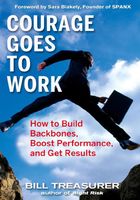
Part I
Setting a Foundation for Courage
People won’t start being courageous just because you tell them to. You’ve got to create an environment that encourages them to extend themselves and take chances. In this section, you’ll be introduced to four actions you need to take before expecting people to be more courageous. These four actions, introduced briefly at the end of chapter 1, constitute the Courage Foundation Model, and they follow a specific order.
The first action deals with role modeling, or what I call Jumping First. Why on earth would you expect people to be courageous if you yourself are wimpy? Your own courageous actions will have the biggest impact on people’s willingness to be courageous.
The second action deals with creating safety. People won’t take chances unless they have at least some degree of support from you. Getting people to take big leaps requires putting some safety nets in place to soften their landing.
Action number three deals with putting fear to work. Few things are as potent as fear in causing people to be risk averse. But fear has energy. Properly harnessed, fear’s energy can be used to help people accomplish and overcome the very thing that may be inspiring their fear. The third action of the Courage Foundation Model is about harnessing fear.
The final action in the model deals with adjusting the degree of comfort and discomfort that workers experience. The idea is to slowly but persistently stretch workers’ capacity to deal with uncomfortable situations by assigning them incrementally greater challenges. Doing so causes them to exert more courage in order to meet the challenging assignments.